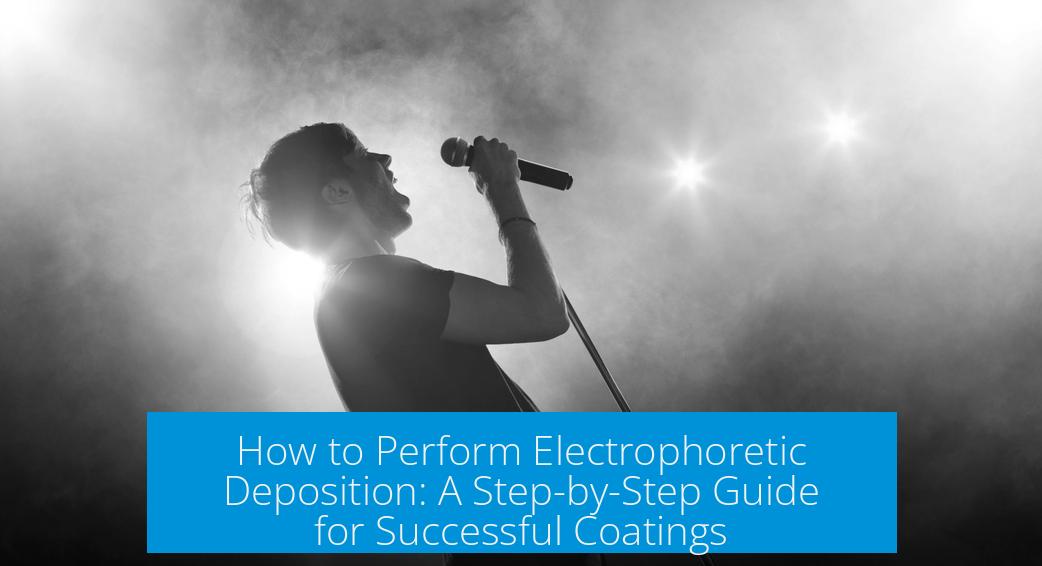How to Perform Electrophoretic Deposition

Electrophoretic deposition (EPD) involves applying an electric field to drive charged particles suspended in a colloidal solution onto an electrode surface. Precise voltage control, proper selection and preparation of materials, stable suspensions, and correct electrode placement are crucial for success.
Voltage Application

Applying the correct voltage is essential. Typical EPD processes operate within specific voltage ranges, often between 1 and 30 volts depending on the system. Using excessively high voltages, such as 28 V without appropriate control, can cause undesirable reactions or damage the setup.
Carefully distinguish between different voltage levels as they affect deposition properties significantly. For example, a 2.8 V potential yields different deposition quality than 24 V.
Materials and Suspension Preparation

Particle type and suspension preparation strongly influence deposition. Carbon black differs from multi-walled carbon nanotubes (MWCNTs) in surfactant solutions; each requires tailored dispersion techniques.
Ensuring particles are well-dispersed and maintain surface charges is essential. The suspension should form a stable colloid where particles do not settle quickly.
Electrode Setup and Positioning

Place both electrodes entirely within the colloidal suspension to establish a uniform electric field. Verify that the solution contains charged particles for migration.
Incorrect electrode placement or incomplete immersion can hinder deposition or generate uneven films.
Suspension Stability

Monitor the colloidal stability over time. Letting the suspension sit unmixed should not result in rapid settling. If particles sediment quickly, the suspension lacks adequate charge balance or stabilizers for uniform deposition.
Practice and Experimentation

Thoughtful planning and verification are critical. Do not follow protocols blindly; understand the chemistry behind each step and adjust parameters based on your system.
Question experimental recipes and verify their sources to ensure reproducibility and reliability in your results.
Summary of Key Points

- Apply appropriate voltage; avoid excessive potentials.
- Prepare stable, charged colloidal suspensions relevant to material type.
- Fully immerse both electrodes in the suspension.
- Ensure suspension remains stable without rapid particle settling.
- Verify and adapt experimental protocols thoughtfully.
How to Perform Electrophoretic Deposition: A Clear Guide with Pro Tips
Electrophoretic deposition (EPD) is a fascinating process that uses electric fields to deposit charged particles onto a substrate, creating uniform coatings essential in fields from electronics to biomedical devices. But how do you actually perform it without ending up scratching your head (or your lab bench)? Let’s dive into the practical how-to, focusing on critical details that make or break your experiment.
First off, many newcomers ask: How do I get the voltage right for electrophoretic deposition? The answer is: precise voltage control is non-negotiable. It’s not a one-size-fits-all game.
Getting Voltage Right: Not All Volts Are Equal
Confusing 24 volts with 2.8 volts or imagining 28 volts where none should be can lead to disastrous results. Think of it like seasoning food: a sprinkle is great, a dump is ruined. In some research papers, 2.8 V is used to create gentle, controlled particle movement in the colloid. Using 24 V or higher? Unless your electrodes are in some ‘Narnia-like’ world, that’s a recipe for burning your sample or triggering unwanted reactions. Always match the voltage to your specific suspension and electrodes. Experimentation without thinking about these numbers is asking for trouble.
The Ingredients Matter: Know Your Materials and Solutions
Next up: Your suspension should not be a random soup. Carbon black and multi-walled carbon nanotubes (MWCNTs) are not interchangeable. One is not just a fancier name for the other. MWCNTs usually suspend in surfactant solutions due to their unique chemistry, while carbon black behaves differently. Mixing these up means your deposition won’t adhere correctly or might not happen at all. So, prepare your suspensions carefully and understand each material’s interaction with the solvent and electric field.
Electrode Setup: Positioning Is Everything
Before switching on the power, check your setup seriously. Are both electrodes submerged fully in the colloidal solution? Yes, electrons won’t jump through the air or across dry spots.
Also, verify your solution functions as a proper colloid—meaning it needs stable, charged particles suspended uniformly. Without this, particles won’t migrate under the electric field, and your deposition layer could end up patchy or non-existent. If your colloid settles too quickly, it’s time to revisit your solution chemistry.
Keeping Your Suspension Suspended: Stability Is Key
Wondering if your suspension stays charged and well mixed? Give it a test: just let it sit. If particles settle and clump at the bottom or stick to the container sides, your suspension needs tweaking. Ideally, the suspension should remain stable long enough for your deposition process to complete. Stabilizers or surfactants might be necessary additives to keep the particles nicely dispersed.
Beyond Mechanics: Think Before You Experiment
Here’s some wisdom often lost in the excitement of setting up experiments: Don’t do chemistry without thinking about it. This applies particularly to EPD because the chemistry-combined-with-electricity can lead to unexpected results, including dangerous side reactions or damaged equipment.
Ask yourself: Why am I using this particular recipe? Where did it come from? Has anyone else confirmed it works? Blindly following an unverified recipe is like taking a shortcut through a jungle without a map—you might get lost or worse. Confirm your methods through trusted literature and colleagues’ advice.
Turning Theory Into Practice: A Simple Step-By-Step
- Prepare your well-dispersed suspension with the right materials, e.g., MWCNTs in surfactant solution or carbon black, ensuring the particles are charged and stable.
- Set up two electrodes properly submerged in the colloidal solution: an anode and a cathode, depending on your target material’s charge.
- Adjust your power supply to the correct voltage. For many suspensions, this ranges between 1 and 5 volts, but always consult your material-specific literature.
- Start the deposition with the electrodes connected, monitoring the time carefully. Overdeposition can cause cracking or peeling.
- After deposition, gently remove the coated substrate and dry it using appropriate methods (air dry, vacuum, etc.)
- Analyze your film’s uniformity, thickness, and adhesion to improve future runs.
What If Something Goes Wrong?
If your deposition looks patchy or doesn’t stick:
- Check if the suspension remained stable.
- Verify electrode placement and submersion.
- Confirm your voltage isn’t too high or too low.
- Review your material selection—is your carbon source compatible with the solution?
Why All This Attention to Detail?
EPD looks deceptively simple—dip, zap, done—but minor missteps can ruin your experiment. Treating EPD like a magic wand spells trouble. It’s a dance between chemistry and physics, requiring thoughtful calibration and patience.
Consider this: a stable colloidal suspension applies disciplined particle motion under carefully tuned voltage. This leads to solid, adherent films with desirable properties. Rushing or ignoring basics turns your efforts into frustration and wasted resources.
In Conclusion: Careful Steps Lead to Perfect Coatings
To perform electrophoretic deposition successfully, focus on controlling voltage accurately, preparing the right colloidal suspensions, positioning electrodes properly, and maintaining solution stability. Above all, approach each run thoughtfully, questioning your sources and methods. With patience and attention to detail, your EPD results will look like they came straight out of a high-tech lab rather than a chemistry experiment gone sideways.
Are you ready to give your deposition setup a reality check? Remember: every volt counts, every particle has a story, and every electrode belongs in the liquid. Happy electrophoretic depositing!
What voltage range should be used for effective electrophoretic deposition?
Use appropriate voltage levels, typically low voltages around 2-3 V work better. Avoid unusually high voltages like 24 V or 28 V that can cause problems in deposition. Proper voltage ensures good film formation.
How do you prepare the suspension material for electrophoretic deposition?
Use the correct material such as carbon black or MWCNTs properly dispersed in a suitable surfactant. The suspension must be stable and charged to allow movement under an electric field.
Is electrode placement important during the deposition process?
Yes, both electrodes need to be fully immersed in the charged suspension. Incorrect placement can prevent deposition or cause uneven coatings.
How can you verify that the colloid suspension is stable for the deposition?
Check if the suspension remains evenly dispersed when left still. A stable colloid does not settle quickly and maintains charge for consistent deposition.
Why is verifying the deposition recipe important before starting the experiment?
Always confirm the source and validity of the recipe. Using unverified protocols can lead to failed or inconsistent deposition results.





Leave a Comment